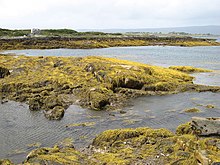Knot tang
| Knot tang | ||||||||||||
|---|---|---|---|---|---|---|---|---|---|---|---|---|

Knotted wrack ( Ascophyllum nodosum ) |
||||||||||||
| Systematics | ||||||||||||
|
||||||||||||
| Scientific name | ||||||||||||
| Ascophyllum nodosum | ||||||||||||
| ( L. ) Le Jolis |
The knotted wrack ( Ascophyllum nodosum ) is a species of brown algae that is widespread in the North Atlantic and is also found in the North Sea and the Baltic Sea. It is used economically to obtain alginic acid .
description
The knotweed is a seaweed with a strong thallus that reaches a size of about 70 cm. Numerous long shoots arise from the adhesive organ that anchors it on the solid ground, and new shoots can grow from them after damage to the thallus. They are loosely branched and expand into swim bladders at almost regular intervals. In older specimens, a new swim bladder is formed every spring so that you can determine the age from it.
Reproduction

The knot wrack is diploid and does not show a generation change . Triggered by the shorter days, tufted short shoots appear on the side of the main shoot in autumn. These ripen during the winter and form club-shaped, yellowish fruiting bodies ( receptacles ) at their ends . The gametes arise there in numerous conceptacles sunk into the shape of a jug . The knot wrack is dioecious , so female and male gametes arise on different thalli. In spring, the egg cells and sperm cells (swarms, zoospores) are released into the water. The egg cells secrete the pheromone Finnavarene , which attracts the sperm cells. In summer the old fruiting bodies and their stems are thrown off.
ecology
The red alga Vertebrata lanosa grows epiphytically as a semi-parasite on the knotwrack.
Limpets of the genus Patella eat the thallus of the knotweed and can push back its populations until they disappear.
Occurrence
The knotwrack is widespread in the North Atlantic from subtropical to arctic zones, it also grows on the coast of Brazil . Although it has occasionally appeared in San Francisco Bay, it does not appear to be permanent in the Pacific. In Europe, its distribution area extends from the Canary Islands to Spitzbergen and also includes the North Sea and the Baltic Sea .
It occurs in the intertidal zone , where it inhabits rocks or walls in protected places. It is mostly found in the vertical zone below spiral wrack and above bladder wrack .
In Brittany , the stocks of knotweed have declined extremely over the last 20 years and have in places completely disappeared. A decline is also observed in Northern Ireland . The seaweed is eaten by limpets in large numbers. Population fluctuations or climate changes are discussed as causes for this.
Systematics
The first description of the knot tang was in 1753 by Carl von Linné under the name Fucus nodosus in Species plantarum , Volume 2, p. 1159. Auguste-François Le Jolis placed the species in the genus Ascophyllum in 1863 (In: List des algues marines de Cherbourg . Mémoires de la Société Impériale des Sciences Naturelles de Cherbourg 10, pp. 5-168). The knotwrack is the only species in the genus Ascophyllum . It belongs to the family of the Fucaceae within the order of the Fucales and is closely related to the genus Fucus .
Synonyms for Ascophyllum nodosum (L.) Le Jolis are Ascophylla nodosa (L.) Kuntze, Fistularia nodosa (L.) Stackhouse, Fucodium nodosum (L.) J. Agardh , Fucus nodosus L., Halicoccus nodosus (L.) Lyngbye and Ozothallia nodosa (L.) Decaisne & Thuret. The following are also considered synonymous: Ascophylla laevigatum Stackhouse, Ascophyllum mackayi (Turner) Holmes & Batters, Ascophyllum mackayi f. robertsonii Batters, Ascophyllum robertsonii (Batters) Batters, Chordaria scorpioides (Hornemann) Lyngbye, Fistularia mackayi (Turner) Stackhouse, Fucodium nodosum var. scorpioides (Hornemann) J.Agardh, Fucus mackayi Turner, Fucus nodosus var. denudatus C.Agardh, Fucus nodosus var. evesiculosus J. Agardh , Fucus nodosus var. siliquatus Turner, Fucus scorpioides Hornemann, Halicoccus nodosus var. furcatus Areschoug, Halidrys siliquosa var. minor Lyngbye, Ozothallia nodosa f. furcata (Areschoug) Kjellman and Ozothallia vulgaris Decaisne & Thuret.
use
The knotted wrack is used to extract alginic acid , which is used in the food industry and in biotechnology . It is also used as a fertilizer . A sustainable aquaculture is conducted in Norway , Ireland and Iceland . In Connemara, Ireland, around 30,000 t are currently harvested by hand and transported to a drying factory.
The seaweed is also used as a packaging material for haddock . When thrown into the sea at their destination, short-lived populations can develop.
Knotweed is also traditionally used in the New England Clam Bake , a traditional preparation of shellfish in an earth oven right on the beach. The shellfish are steamed by the wet knotted wrack.
swell
- Michael Guiry: The Seaweed Site: information on marine algae: Ascophyllum nodosum , accessed February 14, 2013 (sections description, occurrence, use)
- Michael D. Guiry, GM Guiry: Ascophyllum nodosum In: Algaebase - World-wide electronic publication, National University of Ireland, Galway , accessed March 20, 2012 (section systematics, occurrence)
- P. Kornmann, PH Sahling: Sea algae from Helgoland - Benthic green, brown and red algae. Biological Institution Helgoland, Hamburg 1983, ISSN 0017-9957 , p. 168 (section description)
Individual evidence
- ↑ a b Auguste Le Roux: Littoral: Les ceintures de fucacées menacées? In: Tela Botanica 11, 25, 2005.


